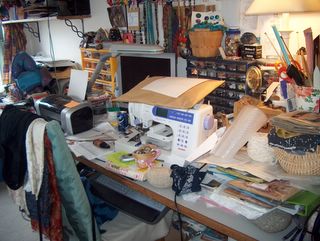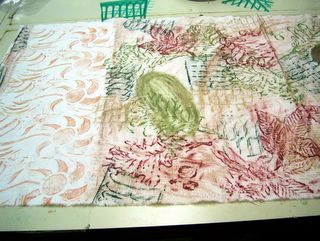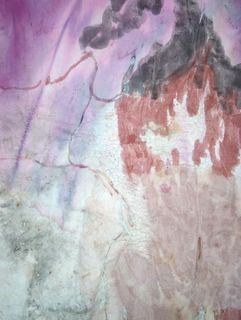Design Studio Remuddle
Due to spring cleaning my studio is now out of commission, hopefully it'll be put back together by tonight!
Shiva Iridescent Blending Stick
The interesting thing about the blending sticks is they don't show up on white fabric, well duh it's transparent. But when I added the ink to the fabrics the iridescent blender markings really popped onto the fabric surface. I will be working with this a bit more once I get the fabric heat set and washed. You can see the markings on the top of the fabric, in the pic where you see the whole fabric, it sorta glows.
Pics Not Coming Up
I've been trying to post pics of the fabric since my last post. Hopefully they will show up soon.
Shiva Fabric, Shipping Tags and Payne's Grey
Updating what I've been doing to the sample piece that was posted a week ago. I'm slowly getting around to pushing the surface further, it's been punctuated with bouts of work.
Anway I applied various inks, Ranger Inks and Tsukineko Walnut Inks, to the surface, it was too white. Now that it has air dried overnight I will heat set the color with an iron and rinse the excess off of the surface. The Ranger Inks I've been using are the Adirondak line, they are in spray bottles and have a tendancy to crock off very easy. The green didn't prove to be wash fast in the past, (the color green I'm using is called Lettuce), but I didn't heat set it with the iron. The reds were very washfast w/o heat setting.
So this begs to be anwsered why would I want to use them on any other surface then? I used the Ranger Ink Pads on shipping tags, one of the colors was called Soot, the other Old Paper. I really like the texture the pads leave on the paper. I did a couple of tags by simply pressing them onto the ink pad. The remaining tags I dropped into a cochineal dye bath and the Payne's Grey dye bath.
Payne's Grey (for a light to medium color) to get this color on fabric/fibers using natural dyes: first an indigo bath, two dips in a weak bath. Rinse/wash the fabric to get rid of the excess indigo. The place fabrics/fibers into a dye bath of Oak Gall Nut Extract, two heaping tablespoons, and a tiny bit of iron mordant, about 1/4 teaspoon. The iron turns the seeminly unimportant drab Oak Gall Extract bath from blah beige to pewter grey. Most excellent color is to be had.
You could overdye any number of colors with this dye bath and end up with a rainbow of exciting colors. Lessen the amount of Oak Gall Extract, to as little as 1/4 teaspoon of extract, if you want to simply tone down another color.
Anway I applied various inks, Ranger Inks and Tsukineko Walnut Inks, to the surface, it was too white. Now that it has air dried overnight I will heat set the color with an iron and rinse the excess off of the surface. The Ranger Inks I've been using are the Adirondak line, they are in spray bottles and have a tendancy to crock off very easy. The green didn't prove to be wash fast in the past, (the color green I'm using is called Lettuce), but I didn't heat set it with the iron. The reds were very washfast w/o heat setting.
So this begs to be anwsered why would I want to use them on any other surface then? I used the Ranger Ink Pads on shipping tags, one of the colors was called Soot, the other Old Paper. I really like the texture the pads leave on the paper. I did a couple of tags by simply pressing them onto the ink pad. The remaining tags I dropped into a cochineal dye bath and the Payne's Grey dye bath.
Payne's Grey (for a light to medium color) to get this color on fabric/fibers using natural dyes: first an indigo bath, two dips in a weak bath. Rinse/wash the fabric to get rid of the excess indigo. The place fabrics/fibers into a dye bath of Oak Gall Nut Extract, two heaping tablespoons, and a tiny bit of iron mordant, about 1/4 teaspoon. The iron turns the seeminly unimportant drab Oak Gall Extract bath from blah beige to pewter grey. Most excellent color is to be had.
You could overdye any number of colors with this dye bath and end up with a rainbow of exciting colors. Lessen the amount of Oak Gall Extract, to as little as 1/4 teaspoon of extract, if you want to simply tone down another color.
porcupine quills and studios
The rest of my porcupine quills came today, about 5000 total. They need to be washed and dyed now, with natural dyes. I don't care for the package they came in, a padded envelope, it's going to be hard getting the quills out intact, and a lot of them appear to be broken already.
I'm almost done rearranging the studio, hubby and I spent the better part of last night picking out and then buying shelf brackets. The only way the new studio arrangement is going to work is to put those books way up on the wall out of my way, and so they don't block my window light. So tonight it's shelf time, I'll be moving most of the books today by myself, and then it's back to dyeing fabrics tomorrow.
I decided to rearrange my studio now, the flow was horrible I couldn't get to anything, the design wall or my supplies. I know that once we get into the new building there would be no time to rearrange my home studio. The new configuration will be similar to the pics that are posted on the blog, only better. Why I changed it from that configuration to what I had, that didn't work, I'll never know.
The shelves with all of the fabric are now in the walk-in closet off of the studio (which once upon-a-time was a master bedroom). That west facing wall is now dedicated to storage units, books and more storage. The south wall, in the old pic with the white storage units, will have my new make shift sewing table up against it, with three more thread racks mounted on the wall above the table. It's amazing how much thread, needles and fabric you can accumulate without even trying. And I haven't even gotten into all of the wool that needs to be washed, carded and spun up, 75 pounds worth.
Once the studio is done, hopefully tonight, I'll post pics of it again, tomorrow when it's sunny. I have some work to do in the walk in closet, I wish there was a more effiecient, less expensive way of storing my fabrics, w/o throwing them onto a shelf. Half of my fabric stash sits in the attic awaiting my attention, it's been there about a month now safely out of harms way.
Need to go check on the corned beef, happy St. Paddy's Day! Now to just convince the dogs that natural sinew, for sewing, is not a doggie chew toy.
I'm almost done rearranging the studio, hubby and I spent the better part of last night picking out and then buying shelf brackets. The only way the new studio arrangement is going to work is to put those books way up on the wall out of my way, and so they don't block my window light. So tonight it's shelf time, I'll be moving most of the books today by myself, and then it's back to dyeing fabrics tomorrow.
I decided to rearrange my studio now, the flow was horrible I couldn't get to anything, the design wall or my supplies. I know that once we get into the new building there would be no time to rearrange my home studio. The new configuration will be similar to the pics that are posted on the blog, only better. Why I changed it from that configuration to what I had, that didn't work, I'll never know.
The shelves with all of the fabric are now in the walk-in closet off of the studio (which once upon-a-time was a master bedroom). That west facing wall is now dedicated to storage units, books and more storage. The south wall, in the old pic with the white storage units, will have my new make shift sewing table up against it, with three more thread racks mounted on the wall above the table. It's amazing how much thread, needles and fabric you can accumulate without even trying. And I haven't even gotten into all of the wool that needs to be washed, carded and spun up, 75 pounds worth.
Once the studio is done, hopefully tonight, I'll post pics of it again, tomorrow when it's sunny. I have some work to do in the walk in closet, I wish there was a more effiecient, less expensive way of storing my fabrics, w/o throwing them onto a shelf. Half of my fabric stash sits in the attic awaiting my attention, it's been there about a month now safely out of harms way.
Need to go check on the corned beef, happy St. Paddy's Day! Now to just convince the dogs that natural sinew, for sewing, is not a doggie chew toy.
Using Pottery Glazes and Fairies
Yes many of the glazes used for painting pottery can be used for painting fabrics as well. You can mix them with soy milk, a little of the iron oxide or pigment will go a long way, I typically use 1 tps to 1 TBS of the pigments and/or oxides to 1 cup soy or acorn milk. When painting wood or leather you can mix the pigments and/or oxides with hide glue.
I typically use acorn milk, as this is what the First Peoples used, and I believe it to be far superior to soy milk. One: it has tannin in the milk aready, from the acorns, and two: it doesn't spoil nearly as fast. I also like the hand afterward, which I feel is superior to soy milk. Howevery, and it's a big however, I have to beat the squirrels to the acorns! That is not an easy task to say the least.
I use the acorn caps as hats for little fairies I'm making. I got the idea from a book called Felt Wee Folk by Sally Mavor , they are absolutely adorable! And I'm not a cute kinda person either. I have adequetly baffled my husband with this habit of making fairies and gnomes. What can I say I can't help myself, and he definately does NOT know what to make of either. It's also a great use of all of those teeny tiny scraps of silk and wool. Oh and did I mention all of those silk flowers I seem to have gathered over the past two decades.
NOTE: Always wear a respirator when handling glazes, iron oxides or pigments of any sort. These things are not good for your lungs or your brain!
I typically use acorn milk, as this is what the First Peoples used, and I believe it to be far superior to soy milk. One: it has tannin in the milk aready, from the acorns, and two: it doesn't spoil nearly as fast. I also like the hand afterward, which I feel is superior to soy milk. Howevery, and it's a big however, I have to beat the squirrels to the acorns! That is not an easy task to say the least.
I use the acorn caps as hats for little fairies I'm making. I got the idea from a book called Felt Wee Folk by Sally Mavor , they are absolutely adorable! And I'm not a cute kinda person either. I have adequetly baffled my husband with this habit of making fairies and gnomes. What can I say I can't help myself, and he definately does NOT know what to make of either. It's also a great use of all of those teeny tiny scraps of silk and wool. Oh and did I mention all of those silk flowers I seem to have gathered over the past two decades.
NOTE: Always wear a respirator when handling glazes, iron oxides or pigments of any sort. These things are not good for your lungs or your brain!
Shiva Paintstiks
Here pics of the Shiva Paintstics used over textured surfaces. I cut up some old fruit baskets, the kind you get from the produce section of the store, and I used some commercial texture plates. You could do this over a stamp that didn't have very fine details, or over a stencil. If you use a stencil you may want to put a spray adhesive on the back to prevent it from slipping around on the fabric when applying the paintsticks.
Let it air dry 72 hours, heat set with an iron and then wash as normal.
I carry the sticks on my webstore http://www.prairiefibers.com Just click on the picture and it will take you to that particular product page.
Let it air dry 72 hours, heat set with an iron and then wash as normal.
I carry the sticks on my webstore http://www.prairiefibers.com Just click on the picture and it will take you to that particular product page.
Wisdom Keeper's 2
You can hardly make it out on this detail shot but there is machine and hand stitching on this piece of fabric. I used a grape cluster type free hand pattern with the machine to create more dimension to the fabric. It looks much better in person. Here are a couple of more pics of this piece of fabric.












